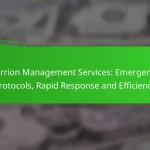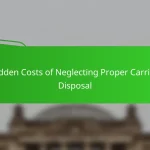Carrion management services play a critical role in public health and environmental safety by implementing emergency protocols for the swift removal and disposal of animal carcasses. These rapid response measures are designed to minimize health risks and adhere to local regulations, ensuring a safe environment for communities. Efficiency metrics further enhance these services by optimizing operations and measuring performance to maintain high standards of service delivery.

What are the emergency protocols for carrion management services?
Emergency protocols for carrion management services are essential procedures designed to address the immediate removal and disposal of animal carcasses in a timely and safe manner. These protocols ensure that health risks are minimized and environmental impacts are managed effectively.
Standard operating procedures
Standard operating procedures (SOPs) outline the step-by-step processes for responding to carrion incidents. These include initial assessment, containment, removal, and disposal methods. For example, personnel should assess the site for hazards, secure the area, and use appropriate equipment for safe removal.
It is vital that all staff are trained in these SOPs to ensure consistency and efficiency during emergencies. Regular drills can help reinforce these procedures and prepare teams for real-life scenarios.
Health and safety guidelines
Health and safety guidelines are crucial to protect workers and the public during carrion management operations. This includes wearing personal protective equipment (PPE) such as gloves, masks, and coveralls to prevent exposure to pathogens. Proper hygiene practices, like handwashing and sanitizing equipment, are also essential.
Additionally, teams should be aware of potential zoonotic diseases associated with carrion and follow protocols for reporting any health concerns. Regular health screenings for workers can help identify any issues early.
Regulatory compliance requirements
Regulatory compliance requirements vary by region but generally include adherence to local environmental and health regulations. For instance, in the EU, waste management directives dictate how animal carcasses must be disposed of, often requiring incineration or rendering.
Organizations should stay updated on relevant laws and ensure that their practices align with these regulations to avoid penalties. Documentation of procedures and disposal methods is often required to demonstrate compliance during inspections.
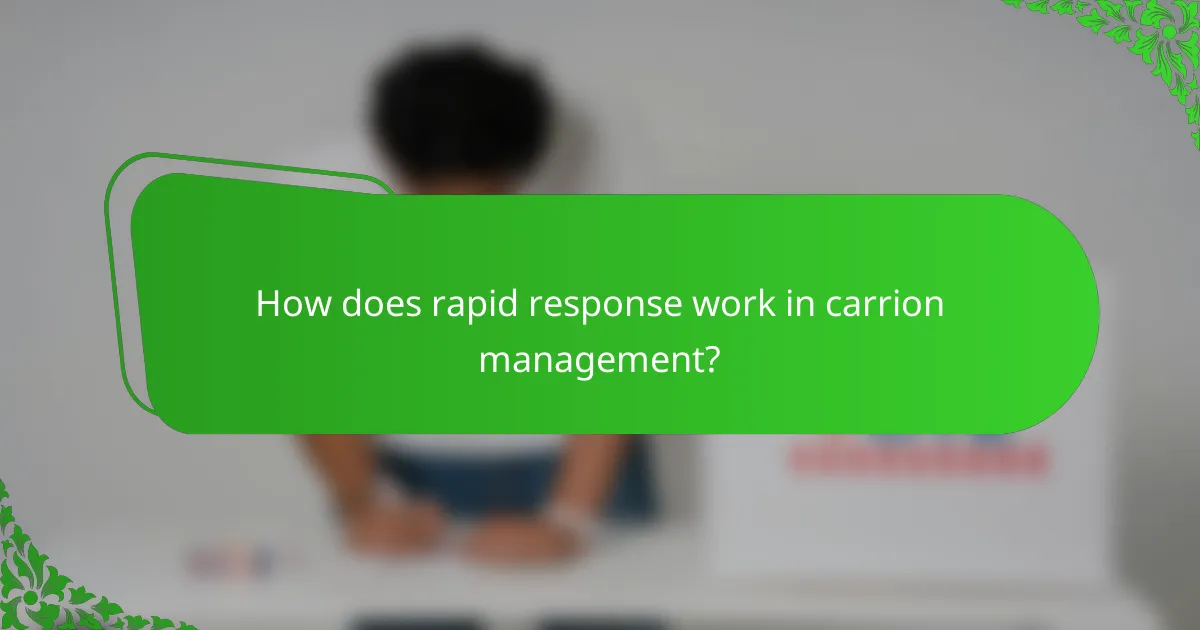
How does rapid response work in carrion management?
Rapid response in carrion management involves swift action to remove deceased animals, minimizing health risks and environmental impact. This process is crucial for maintaining public safety and adhering to local regulations.
24/7 availability of services
Carrion management services operate around the clock to ensure timely response to incidents. This 24/7 availability allows for immediate action regardless of the time of day, which is essential for preventing potential health hazards.
Many service providers have dedicated teams ready to respond at any hour, ensuring that no matter when a call comes in, help is on the way. This continuous availability is a key factor in effective carrion management.
Response time benchmarks
Response times in carrion management typically range from a few minutes to a couple of hours, depending on the location and service provider. Urban areas often see quicker responses, sometimes within 30 minutes, while rural locations may take longer.
Establishing clear benchmarks helps set expectations for clients and ensures that services remain efficient. It’s advisable to inquire about specific response times when selecting a provider to ensure they meet your needs.
Coordination with local authorities
Effective carrion management requires coordination with local authorities to comply with regulations and ensure public safety. Service providers often work closely with animal control, health departments, and environmental agencies.
This collaboration ensures that all necessary permits are obtained and that the removal process adheres to local laws. Engaging with local authorities can also facilitate quicker responses and streamline the management process.

What are the efficiency metrics for carrion management services?
Efficiency metrics for carrion management services focus on key performance indicators that measure the speed, cost, and satisfaction levels associated with the removal of animal remains. These metrics help service providers optimize their operations and ensure compliance with local regulations.
Time to removal
Time to removal is a critical efficiency metric in carrion management, typically measured in minutes or hours. Rapid response times are essential, especially in urban areas where health risks can escalate quickly. A standard target for removal is often within a few hours of notification, depending on the location and accessibility.
To enhance efficiency, service providers should establish clear communication protocols and maintain a well-trained team ready for immediate deployment. Utilizing GPS technology can also help in optimizing routes for quicker response times.
Cost-effectiveness analysis
Cost-effectiveness analysis evaluates the financial efficiency of carrion management services by comparing the costs incurred to the benefits achieved. Factors such as labor, equipment, and disposal fees are considered against the potential health and environmental risks mitigated by timely removal.
Service providers should regularly review their pricing structures and operational costs to ensure competitive rates while maintaining high service standards. Implementing bulk service agreements can also lead to cost savings for clients.
Client satisfaction ratings
Client satisfaction ratings are essential for assessing the overall effectiveness of carrion management services. Feedback from clients can provide insights into areas for improvement, such as response time, professionalism, and thoroughness of the service provided.
To enhance client satisfaction, service providers should actively seek feedback through surveys and follow-up communications. High satisfaction ratings often correlate with repeat business and referrals, making it crucial to address any concerns promptly and effectively.

What factors should you consider when choosing a carrion management service?
When selecting a carrion management service, consider their experience, the technology they use, and the areas they cover. These factors will significantly impact their efficiency and effectiveness in handling emergency situations.
Experience and expertise
Experience is crucial in carrion management, as it ensures that the service provider is familiar with various scenarios and regulations. Look for companies with a proven track record in the industry, ideally with several years of operation and positive client testimonials.
Expertise in handling different types of carrion, including large animals and hazardous materials, is also important. A knowledgeable team can navigate complex situations, ensuring compliance with local regulations and minimizing health risks.
Equipment and technology used
The equipment and technology employed by a carrion management service can greatly affect their response time and efficiency. Advanced tools, such as specialized vehicles and containment systems, enable quicker and safer removal of carcasses.
Additionally, look for services that utilize tracking and communication technology to provide real-time updates. This transparency can enhance coordination during emergencies and improve overall service reliability.
Service area coverage
Understanding the service area coverage is essential when choosing a carrion management provider. Ensure that they can respond promptly to your location, as delays can lead to health hazards and regulatory issues.
Some companies may have limitations based on geography, so verify their operational boundaries. A provider with a wide coverage area is often better equipped to handle emergencies in various locations, ensuring faster response times.
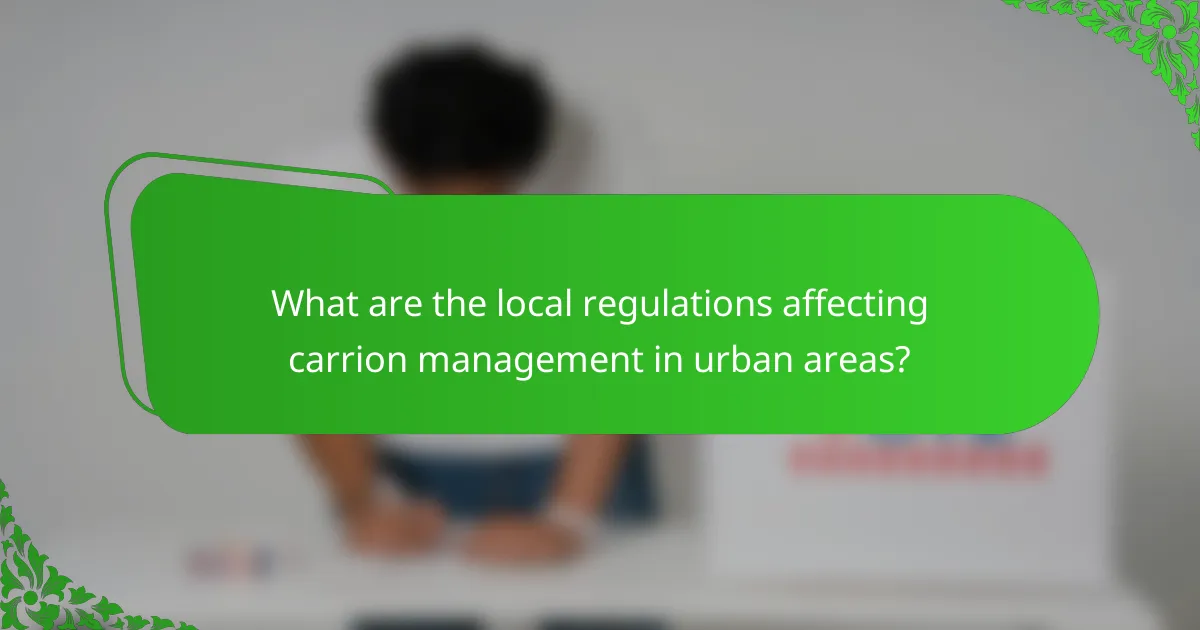
What are the local regulations affecting carrion management in urban areas?
Local regulations for carrion management in urban areas typically involve guidelines on the proper disposal of animal remains to ensure public health and environmental safety. These regulations can vary significantly between cities, often reflecting local environmental concerns and public health standards.
City-specific ordinances
City-specific ordinances govern how carrion must be handled, including removal timelines, disposal methods, and notification procedures. For instance, some cities may require that animal carcasses be reported within a certain timeframe to local authorities, while others may have designated disposal sites. Compliance with these ordinances is crucial to avoid fines and ensure community safety.
Environmental impact assessments
Environmental impact assessments (EIAs) are often required before implementing carrion management services, especially in sensitive urban areas. These assessments evaluate the potential effects of disposal methods on local ecosystems. For example, an EIA might analyze how the decomposition of carrion could affect soil and water quality in nearby parks or residential areas.
Permitting processes
The permitting process for carrion management services typically involves submitting applications to local health departments or environmental agencies. Applicants must provide detailed plans outlining their methods for collection, transportation, and disposal of animal remains. It’s essential to ensure all necessary permits are obtained before beginning operations to avoid legal issues and ensure compliance with local laws.
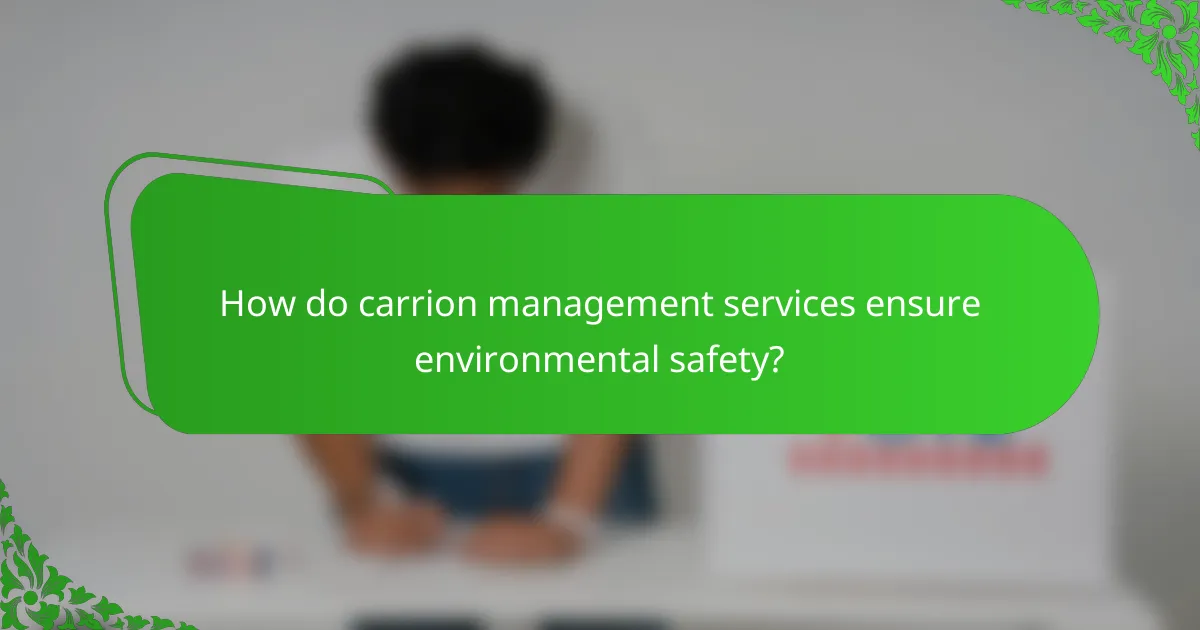
How do carrion management services ensure environmental safety?
Carrion management services prioritize environmental safety by implementing systematic protocols for the disposal of animal remains. These services utilize a combination of disposal methods, biodegradable materials, and partnerships with environmental agencies to minimize ecological impact.
Disposal methods
Effective disposal methods are crucial for maintaining environmental safety in carrion management. Common techniques include incineration, composting, and rendering, each with its own benefits and drawbacks. For instance, incineration reduces waste volume significantly but may release emissions, while composting can enrich soil but requires careful monitoring to avoid attracting pests.
Choosing the right method often depends on local regulations, the type of animal remains, and the volume of waste. For example, large-scale operations may prefer rendering for its efficiency, while smaller entities might opt for composting due to its lower cost and environmental benefits.
Use of biodegradable materials
Utilizing biodegradable materials in carrion management helps reduce long-term environmental impact. This includes using compostable bags and containers for transporting remains, which can decompose naturally and minimize landfill contributions. Such materials are often made from plant-based sources, making them a sustainable choice.
When selecting biodegradable options, it’s essential to ensure they meet local composting standards. This ensures that they break down effectively in the intended disposal environment, contributing to a more sustainable waste management cycle.
Partnerships with environmental agencies
Collaborating with environmental agencies enhances the effectiveness of carrion management services. These partnerships can provide access to resources, expertise, and regulatory guidance that ensure compliance with environmental laws. Agencies may also offer educational programs to raise awareness about proper disposal practices.
Engaging with local environmental organizations can lead to community initiatives that promote responsible carrion management. This not only helps in managing waste effectively but also fosters a culture of environmental stewardship among residents and businesses.
